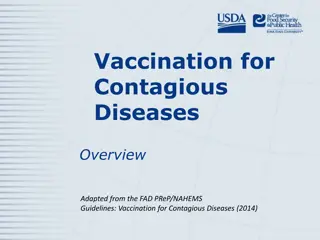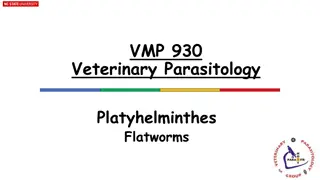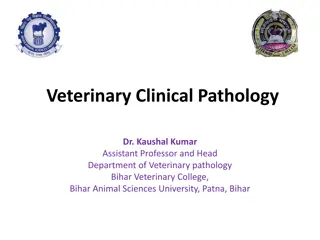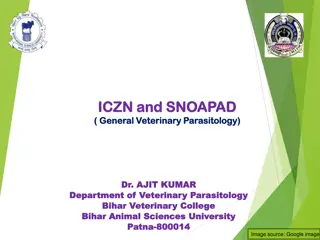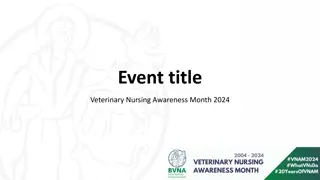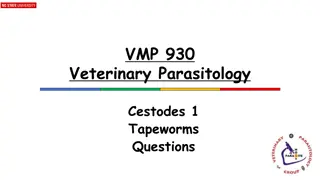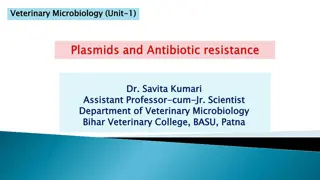Introduction-to-Brijon-Veterinary-Clinic.pptx
At Brijon veterinary Urgent care we are committed to achieving a higher standard for veterinary care. By providing expert care to pets in a timely manner, we strive to treat every dog or cat like our own.\n
5 views • 6 slides
Brijon-Veterinary-Urgent-Care.pptx
Elevate your pet's well-being with Brijon Veterinary Urgent Care, your local partner committed to more than just exceptional veterinary services. We go the extra mile in contributing to the overall health and happiness of pets across Massachusetts. Through active community engagement and educational
8 views • 7 slides
Veterinary Vaccines Market Poised for Growth, Predicts Meticulous Research®
Veterinary vaccines are integral to the veterinary healthcare industry as they help prevent diseases and their spread. They also reduce the risk of transmission of infections from household pets to their owners. Several types of vaccines, such as live attenuated, inactive, recombinant, and other vac
0 views • 3 slides
Understanding Veterinary Parasitology: Mites, Poultry Mite Characteristics, and Minor Mites Quiz
Explore the world of veterinary parasitology with a focus on mites, including poultry mite characteristics and a quiz on minor mites. Learn about different mite species affecting birds and animals, their identification, traits, and management. Delve into distinguishing features, clinical signs, and
5 views • 20 slides
Understanding Tapeworms in Veterinary Parasitology
This comprehensive guide delves into the world of cestodes, focusing on tapeworms. From the general characteristics of flatworms to the intricate life cycle of cestodes, including their presence in large and small animals, this resource provides valuable insights. Explore the morphology of different
7 views • 24 slides
Addressing the Veterinary Clinical Faculty Workforce Crisis at UMN
Veterinary institutions like UMN are facing a critical shortage of clinical faculty, hindering their ability to train specialists and meet the growing demand for veterinarians. To combat this issue, UMN is proposing a unique license to attract highly qualified faculty from non-accredited schools, en
3 views • 7 slides
Veterinary Vaccination Guidelines and Regulation Overview
This presentation provides an overview of veterinary vaccination guidelines and regulations, covering topics such as the National Veterinary Stockpile, types of vaccines, vaccine delivery, storage, and handling. It also discusses the regulatory framework governing veterinary vaccines and the role of
5 views • 30 slides
Understanding Flatworms and Roundworms in Veterinary Parasitology
This comprehensive content explores the world of flatworms and roundworms in veterinary parasitology. It covers various classes such as Turbellaria, Monogenea, Trematoda, and Cestoda, detailing their characteristics, importance in veterinary medicine, and complex life cycles. The content touches on
1 views • 34 slides
Veterinary Parasitology: Liver Fluke Questions and Matching Scenarios
Explore a series of questions and matching scenarios related to liver fluke infections in ruminants, focusing on Fasciola hepatica and related helminth diseases. Discover clinical signs, associations, and key details encompassing different parasitic worms and their impact on animal health.
0 views • 11 slides
Ethics in Veterinary Medicine: Addressing Ethical Dilemmas in Animal Care
Ethics in veterinary medicine focuses on the moral aspects of human behavior and decision-making when faced with conflicting choices. It explores key issues such as animal surgeries, hospitalization, and euthanasia, aiming to determine the most ethical course of action in treating animals. Veterinar
0 views • 30 slides
Veterinary Suturing Techniques and Materials Overview
Understanding the principles of suturing in veterinary surgery is crucial for effective wound closure. This article covers different suturing techniques such as apposition, inversion, and miscellaneous sutures, along with details on needle handling, tissue penetration depth, and suture placement. Im
1 views • 14 slides
Understanding Tarsal Bone Anatomy in Veterinary Science
Tarsal bones in veterinary anatomy play a crucial role in the structure of an animal's hind limbs. Comprising five short bones arranged in distinct rows, including the tibial, fibular, and central tarsals, the tarsus supports movement and stability. The largest tarsal, known as the calcaneal tubercl
1 views • 24 slides
Overview of Sedatives and Hypnotics in Veterinary Pharmacology
This chapter discusses the classification, salient features, and uses of sedatives and hypnotics in veterinary pharmacology. Sedatives subdue excitement and induce calmness without necessarily causing sleep, while hypnotics induce and maintain sleep. Both classes of drugs act as CNS depressants and
1 views • 23 slides
Ultimate Guide to Becoming an Outstanding Veterinary School Applicant
Prepare yourself for veterinary school by excelling in college, taking recommended courses, maintaining a high GPA, gaining veterinary experience, and getting involved on campus. Focus on academics, get involved in extracurricular activities, and start preparing early for standardized tests such as
1 views • 25 slides
Kentucky Veterinary Medicine Practice Act Modernization Initiative Overview
Kentucky Veterinary Medical Board of Examiners (KBVE) has undertaken a comprehensive modernization effort for the state's Practice Act. The initiative involves reviewing national models, engaging professional associations, and collaborating with key stakeholders to propose updates. The modernization
1 views • 15 slides
Comprehensive Guide to Ophthalmic Examination in Veterinary Medicine
A detailed guide on the ophthalmic examination of animals led by Dr. Bipin Kumar, Assistant Professor at the Bihar Veterinary College. The examination covers history taking, general physical examination, evaluation of vision, pupil function, eyelid function, adnexal and anterior segment examination,
1 views • 9 slides
Understanding Parasitism in Medical Parasitology by Prof. Dr. Ahmed Ali Mohammed
Prof. Dr. Ahmed Ali Mohammed delves into the intriguing world of parasitism, exploring the complex relationships between parasites and hosts. He explains the various types of relationships in parasitology, such as symbiosis, mutualism, commensalism, and parasitism, shedding light on how parasites in
0 views • 23 slides
Evolution of Veterinary Surgery: Insights from Ancient India to Modern Innovations
Delve into the historical perspective and advancements in veterinary surgery, starting with ancient Indian veterinarians like Salihotra and Palakapya, through the foundational work of Susruta Samhita, to the modern developments in surgical methods like anesthesia, microbiology, antibiotics, and bloo
4 views • 18 slides
Overview of Veterinary Clinical Pathology and Importance of Anticoagulants
Veterinary clinical pathology involves the laboratory diagnostics and analysis of bodily fluids and tissues to support the diagnosis, treatment, and prevention of diseases. This field encompasses interpreting blood tests, blood smear examinations, and the use of various anticoagulants in specimen co
3 views • 46 slides
Care and Management of Pregnant Animals in Veterinary Practice
This comprehensive guide by Dr. Alok Kumar, Assistant Professor and Scientist in Veterinary Gynaecology and Obstetrics at Bihar Veterinary College, covers key aspects of care and management of pregnant animals, including objectives, conception management, pregnancy diagnosis, nutritional management,
5 views • 19 slides
Understanding Parasitic Relationships in Medical Parasitology
Medical Parasitology delves into the intricate relationships between parasites and their hosts, encompassing symbiosis, mutualism, commensalism, and parasitism. The success of a parasite hinges on achieving a delicate balance with its host, avoiding expulsion or harm. Various types of parasites are
0 views • 12 slides
Faecal Examination Techniques in Veterinary Parasitology at Bihar Animal Sciences University
Explore the practical techniques and methods used for faecal examination in veterinary parasitology at Bihar Animal Sciences University. Learn about qualitative and quantitative methods, egg identification, artifacts, and important principles like floatation method. Visual aids and detailed descript
0 views • 23 slides
Understanding Naming Rules in Veterinary Parasitology
Explore the essential rules and regulations defined by the International Code for Zoological Nomenclature (ICZN) in the field of General Veterinary Parasitology. Learn about the nomenclature of parasites, scientific naming conventions for genera and species, and the classification of parasites in th
1 views • 14 slides
Understanding Sarcocystis Parasites in Veterinary Parasitology
Veterinary Parasitology delves into the study of Sarcocystis parasites, focusing on their morphology, life cycle, and impact on hosts. The Sarcocystidae family, including species like Sarcocystis hominis and S. suihominis, are examined for their pathogenicity in carnivores and herbivores, shedding l
1 views • 11 slides
Veterinary Parasitology: Flea & Lice Overview
Explore the world of veterinary parasitology with a focus on fleas and lice. Dive into topics such as the life cycle of fleas, their preferred habitat, pathology concerns, and Flea Allergy Dermatitis. Learn about identifying stages in the flea life cycle, common flea species, and how to manage Flea
0 views • 16 slides
Veterinary Parasitology Flies: Identification and Pathologies
This content covers information related to veterinary parasitology focusing on flies, their scientific names, common names, characteristics, and pathologies associated with them. It also includes details on types of myiasis, bot characteristics, and filth fly characteristics, providing a comprehensi
0 views • 8 slides
Veterinary Nursing Awareness Month 2024
Celebrate Veterinary Nursing Awareness Month in 2024 with informative and engaging content slides. Explore important messages and takeaways to promote awareness and appreciation for veterinary nursing. Join the campaign to recognize the valuable contributions of veterinary nurses across the globe. S
0 views • 4 slides
Understanding Parasitology: A Comprehensive Overview
Parasitology is the study of parasites, their hosts, and the interactions between them. This field explores the different aspects of parasitism, including the relationships between parasites and hosts, the classification of major parasite groups like protozoa, helminths, and arthropods, and terms cr
0 views • 16 slides
Understanding Lung and Blood Flukes in Veterinary Parasitology
Learn about Paragonimus kellicotti, a lung fluke affecting pets and humans, its life cycle, pathology, diagnosis, and treatment. Explore Heterobilharzia americana, a blood fluke found in dogs along the Gulf Coast States, with unique characteristics and zoonotic implications. Discover the clinical im
0 views • 12 slides
Overview of Veterinary Toxicology Syllabus and Topics Covered
Detailed overview of the Veterinary Toxicology syllabus including general toxicology, toxicity caused by metals and non-metals, poisonous plants, agrochemical toxicity, fungal and bacterial toxins, venomous bites and stings, and more. The syllabus covers a wide range of topics related to toxicology
0 views • 12 slides
Agricultural and Veterinary Chemicals Regulation in Australia - Overview
The regulation of agricultural and veterinary chemicals in Australia is overseen by the Australian Pesticides and Veterinary Medicines Authority (APVMA), established in 1993. The APVMA is responsible for assessing and registering pesticides and veterinary medicines to ensure their safety and effecti
0 views • 15 slides
Understanding Tapeworm Infections in Veterinary Parasitology
Explore key concerns related to different tapeworm infections such as Taenia pisiformis, Taenia taeniaformis, Taenia saginata, Taenia solium, and Echinococcus. Learn about companion animal, economic, and human health concerns associated with these infections. Discover how humans can become infected
0 views • 8 slides
Understanding Parasitology: An Introductory Overview by Dr. Saif alshalah
Parasitology, as elucidated by Dr. Saif alshalah, delves into the science of parasites and their impact. This discipline encompasses medical parasitology, the study of parasitic agents causing diseases in humans. The definition and classification of parasites based on their nature, association with
0 views • 12 slides
Understanding Parasitology in Veterinary Medicine by Prof. Dr. Suzan A. Al-azizz
Parasitology is a vital study of parasites and their hosts, encompassing various disciplines like cell biology, bioinformatics, genetics, and ecology. This field emphasizes the binomial system of species naming pioneered by Linnaeus. The essence of human scientific naming is exemplified by Homo sapi
0 views • 16 slides
Veterinary Parasitology: Tapeworm Infections and Concerns
Explore the concerns associated with various tapeworm infections such as Taenia pisiformis, Taenia taeniaformis, Taenia saginata, Taenia solium, and Echinococcus. Learn about the risks to companion animals, economic implications, and human health consequences. Discover how humans can become infected
0 views • 8 slides
Overview of Strongyloidea Parasites in Veterinary Parasitology
This informative text covers the morphology, life cycle, and common genera of Strongyloidea parasites, including Ancylostoma caninum and Bunostomum sp. It also discusses the occurrence of cutaneous larva migrans and details the Superfamily Trichostrongyloidea. Profound insights into practical parasi
0 views • 11 slides
Understanding Parasitology: The Study of Organisms Living on or within Hosts
Parasitology is the study of parasites, which are organisms that live on or within a host and derive nutrients from them without benefiting the host. Parasites can be classified as ectoparasites or endoparasites based on their location in or on the host. Hosts play a crucial role in the life cycle o
0 views • 23 slides
Assistant Professor Dr. Savita Kumari at Bihar Veterinary College, BASU, Patna
Dr. Savita Kumari serves as an Assistant Professor in the Department of Veterinary Microbiology at Bihar Veterinary College, BASU, Patna. She is actively involved in teaching and research in the field of Veterinary Microbiology.
0 views • 20 slides
Veterinary Parasitology Course Syllabus
This veterinary parasitology course covers major parasites of domestic animals, their life cycles, clinical signs, diagnostic techniques, treatment plans, and zoonotic concerns. The syllabus includes recommended texts, schedule of lectures and exams, lab group decisions, and details on examinations
0 views • 10 slides
Veterinary Medical Terminology: Introduction to Body Planes and Common Terms
Explore the fundamental aspects of veterinary medical terminology, focusing on body planes, common terms for body parts, and root words. Learn about directional terms and how to use them appropriately in a veterinary context. Images and information from "Veterinary Medical Terminology, 2nd edition b
0 views • 20 slides






